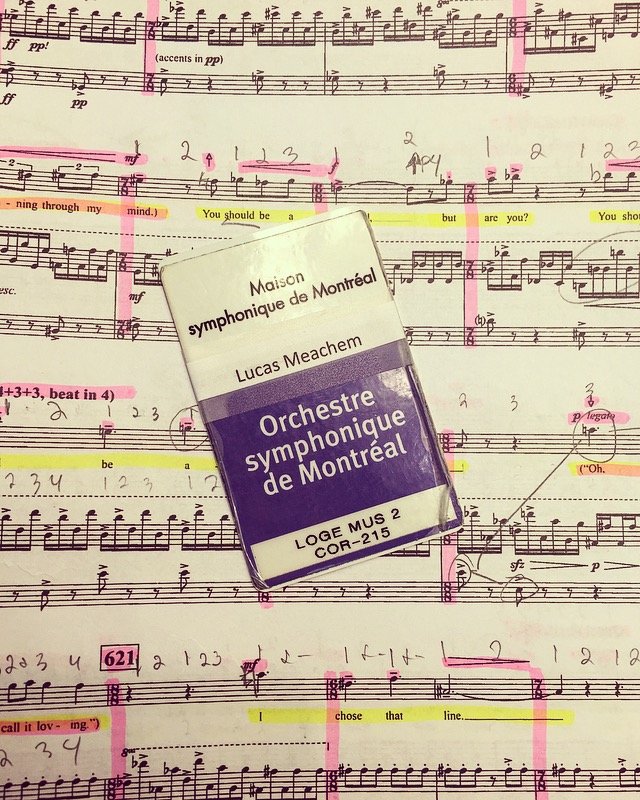
Last week presented me with the biggest challenge of my operatic career so far: learning a role in just 5 days.
And not just any role. This was Sam from Bernstein’s A Quiet Place—that means loads of 5/8, 7/8, and 9/8 time signatures, constant meter changes, counter-intuitive pitches, complex characters… the list goes on!
Due to a last-minute cancellation, I was asked to learn the role for a concert and recording with the Orchestre Symphonique de Montréal. It was the hardest role I had ever looked at, and I only had 5 days to do it.
On top of the music cramming, in those 5 days I had a performance of Don Giovanni at the Semperoper in Dresden, and an insane travel schedule consisting of one night in Dresden, then Amsterdam, and then Minneapolis before reaching my final destination in Montreal.
Now looking back, I realize how crazy I was to have accepted the job in the first place, but I’ve come to find that I thrive in these types of situations: the risk and excitement of taking on a challenge that will push me to the edge of my potential.
So how did I manage to learn this thing? And can anyone do it? Here is my step-by-step process.
1. Listen to a Recording
This seems like a controversial first step, but when you only have a few hours to tell your agent whether or not you’re going to step in for a concert on the other side of the world, … you need to know if you can sing the thing or not!
I was sent the score and a recording by OSM to decide if the role fit my voice, and if I could actually pull off learning it.
I listened closely to the recording while reading the music. This piece is somewhat obscure, so I only had one source to listen to (which was beneficial in terms of time, in that I didn’t have to compare recordings or anything like that).
I listened for the vocal range of the role, the difficulty of the part, and the length of music I would have to learn.
At this point, I decided it was doable, but that it was going to push my brain like it’s never been pushed before. Vocally, I noticed the role was not too virtuosic or taxing, and that my challenge would lie in managing the rhythms and pitches.
So, as you listen closely for the first time, find the most challenging aspects of the role and judge from there whether or not it can be easily crammed.
2. Grab Those Highlighters!
If your music is organized, your learning will be organized, and thus your singing will be organized.
Grab your color-coded writing utensils and get to it! I start with highlighting my entire part while actively listening to the recording.
Then I go back and choose a different color for meter changes or tempo markings, another color for dynamics and articulation markings, and then a whole other color for any acting directions.
But find a system that works for you.

3. Che lingua?
Luckily, in this case, the role was in English so I didn’t have to do any translating or phonetics. But you never know what language you might have to sing in, and that step takes a lot of extra time.
Even if you might have to sing in Italian (one of easier languages to sing in terms of phonetics) you still have to understand what you and everyone else on stage is saying.
This can be time consuming but is imperative for your final product.
4. Rhythm, Rhythm, Rhythm
Start with speaking the rhythm away from the pitches.
The rhythms need to be in your body before you move onto the more challenging next step of figuring out pitches. There is no guessing in rhythm: it needs to be exact. Conduct yourself because if you can’t conduct yourself (or make sense of the meter), then no one can.
On the bright side, this step can be done away from a piano.
5. I Got 99 Problems but my Pitch Ain’t One
This is where the gritty work starts.
You gotta play those pitches at the piano and work them into your muscle memory like there’s no tomorrow.
This step is by far the most intense for me. I have a few practicing techniques I use when I’m ingraining pitches:
- Sing the melody out of rhythm to hear the pitch relations
- Play the harmony, or invent one underneath a pitch that doesn’t make sense
- Can’t seem to land a pitch? Sing up until the pitch and stop on it, and repeat that section a few times
- If you have a recording you are listening to, play it and sing along then pause it just before the troublesome pitch but keep singing! After you’ve sung the pitch, play it on the piano to see if you got it right.
Having trouble finding your starting note? Become a pitch detective.
If you start on a C sharp, look backwards from that pitch and find that same pitch somewhere in the orchestra or in a colleague’s line. Then, learn your colleague’s line, or hum the orchestra part, and keep that C sharp in your head until your cue to use for your entrance.
6. Rinse and Repeat
Nothing is going to help you more than repetition.
Break your long musical lines into smaller phrases and learn them one at a time. Once you have the small phrases down, slowly work your way to entire pages, and then entire numbers. It needs to be in your body, and you’ll know you’re ready when you’re not second-guessing yourself anymore.
Keep listening to the recording when you’re not practicing, and just shove that music into your brain.
You’ll soon be waking up in the middle of the night singing the phrases because they’re beginning to stick. It’s maddening, but it’s a good sign.
7. Get a Coach
Before the first orchestra rehearsal, you have to know what to anticipate from the conductor and the other instruments.
A recording can only do so much for you, and that’s why you have to work one on one with a pianist or coach who knows what they’re doing.
If their sight-reading skills are on point, they don’t need to be an expert in the opera you’re learning. It’s important for you to hear the orchestral cues, other sung lines, and a steady tempo underneath you. It’s also great if the coach can lend an ear and help you out with any obvious pitch or rhythm mistakes you may not realize you’re making.
I have the very special privilege of being married to an opera coach. She’s my secret weapon in all of this. It’s truly a luxury to have her with me for all of my gigs since she is such a talented musician and she is now vital to my performing.
Especially in any music-learning situation, she is always there for me. Without her help, I wouldn’t have been able to accept this gig. She practiced with me hour after hour, day in and day out. Thank you, Irina Meachem! 🙂
8. Understand the Character
Take some time for character analysis.
Make a character-relation map of the entire opera and do some research on the original story. It’s important to arrive to the first rehearsal with some ideas about the character, instead of being a blank slate for the director/conductor.
Not every phrase has to be emotionally affected at first.
If some phrases are challenging rhythmically or melodically, I tend to focus on those difficulties instead of the drama. This is okay when you’re first learning, but when those phrases get easier, push yourself to connect with the emotion and find the motivation.
9. Go Easy on Yourself
The most detrimental component to this entire process is being too hard on yourself, and frankly, I am really bad at this part.
If there were a swear jar in the practice room during my role learning I wouldn’t end up with much of a fee. As you are learning, appreciate all of the work you do while knowing there is a lot more to come.
If you become too demanding of yourself or impatient with the process, you may frustrate yourself beyond the point of repair. Believe in your learning abilities, and be reasonable about the fact that it’s not going to settle in overnight.
Talk with your co-workers about your learning process once you arrive to rehearsal and most likely, they will be supportive and help you along the way. Get extra time with the staff members and have an open dialogue with the conductor. You’ll need that added support when you’re in crunch time.
For an in-depth look at my recent cramming process with the OSM and the role of Sam, here’s a behind-the-scenes vlog of what this crazy week really was like:

0 thoughts on “Is it Possible to Learn a Role in Just 5 Days?”